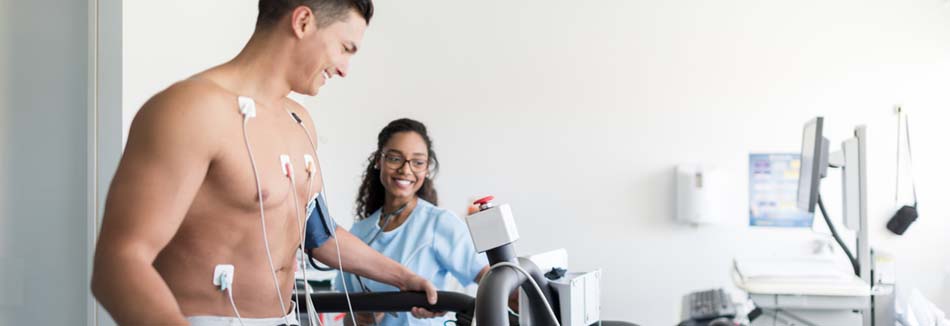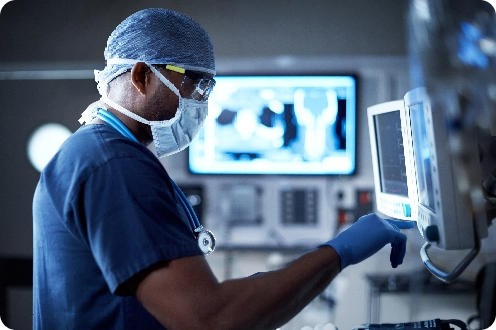Heart and Vascular Services
Why Choose the Baptist Heart Institute?
Baptist Memorial Health Care understands the importance of high-quality heart and vascular diagnostics, treatment and prevention. That’s why we established the Baptist Heart Institute.
The best part about this leading-edge facility is the convenience. We’ve combined all heart services into one location to support high-quality care, research, education and data management.

Heart Disease Treatment at Baptist
Heart disease kills nearly 2,400 Americans every day.1 Our team of trained cardiologists and surgeons delivers advanced diagnostics and treatment to help Mid-South patients achieve and maintain heart health. Some of the many heart and vascular conditions we treat at Baptist include:
- Aneurysm: a bulging or a weakness in the wall of a blood vessel
- Angina: chest pain that can extend to the left arm, shoulder or jaw
- Arrhythmias: irregular heartbeat (too fast/too slow or skipping beats), including atrial fibrillation
- Cardiomyopathy: diseases in coronary muscle tissue, including an enlarged heart
- Coronary heart disease: coronary artery disease, peripheral artery disease and carotid artery disease
- Heart attack: (myocardial infarction), an interruption of the blood supply to the heart’s muscle tissue
- Heart failure: weakened or damaged heart muscle causing the heart to work too hard to keep up with the body’s blood demands
- Peripheral artery and peripheral vascular disease: Narrowing of arteries that reduce blood flow to your limbs
- Stroke (including ischemic and hemorrhagic strokes and transient ischemic attacks (TIAs)): occurs when a blocked blood vessel deprives areas of the brain of oxygen – because this problem ends up affecting the brain, neurologists may collaborate with the heart specialist on stroke cases.
- Valvular heart disease: heart valve damage caused by rheumatic fever, infections, connective tissue disorders, radiation treatments or medications
Heart and Vascular Diagnostic Tests
Diagnosis is the first step in treating heart disease. The following are just some of the tests available at Baptist Heart Institute.
Catheterization procedures and tests
These procedures help cardiologists diagnose and treat certain cardiovascular conditions, such as disease of the heart muscle, valves or coronary arteries. During cardiac catheterization, a long thin tube called a catheter is inserted in an artery or vein in your groin, neck or arm and threaded through your blood vessels to your heart.
Electrophysiology procedures and tests
Electrophysiology (EP) focuses on the electrical system of your heart. Baptist’s cardiologists perform procedures such as cardioversion, EP studies and ablations and tilt table tests. They also implant permanent pacemakers, internal cardiac defibrillators, biventricular pacemakers and defibrillators and internal loop recorders.
1Source: American Heart Association, based on 2019 data
View All Diagnostics Offerings
Baptist Comprehensive Pulmonary Hypertension Center
Baptist Heart Institute is home to the first pulmonary hypertension center in the Mid-South. The Baptist Comprehensive Pulmonary Hypertension Center specializes in diagnosing, treating and managing pulmonary hypertension, an umbrella term used to describe a group of diseases that cause high pressures in the lung circulation.
Treating and managing pulmonary hypertension is complex. However, most pulmonary hypertension centers in the nation are run by either pulmonologists or cardiologists, but not both. Experience has taught us that a dedicated multidisciplinary team including pulmonologists, cardiologists, specialty pharmacists, nurses and respiratory therapists is vital to delivering the best care for such a complex condition. At Baptist Comprehensive Pulmonary Hypertension Center, we were able to establish such a team and we see the strength of this multidisciplinary approach in almost all of our patients.
If not treated in timely manner, certain forms of pulmonary hypertension can cause more serious problems. Symptoms can be elusive and nonspecific leading to delayed diagnosis. Furthermore, managing this condition is highly specialized and very specific to the kind of pulmonary hypertension the patient has, which makes timely treatment that much more important. The Baptist Comprehensive Pulmonary Hypertension Center is the only clinic in the Mid-South with experienced physicians and other health care professionals who specialize in the early detection and treatment of this condition.
Baptist Heart Fund
Baptist Memorial Health Care Foundation's Heart Fund provides financial support for initiatives that benefit heart patients and their care. Donations are earmarked for research, equipment, staff education and other patient-related needs. The fund has provided thousands of dollars for equipment for heart patients, including the HeartMate® left ventricular assist devices that keep heart transplant patients alive while they await donor hearts.
Heart and Vascular Care Locations
Several Baptist Memorial hospitals offer a wide range of heart services. Learn more about the heart care our hospitals offer.
Arkansas
-
NEA Baptist Memorial Hospital
MAP4800 East Johnson AveJonesboro, AR 72401Heart and Vascular Services: Cardiac Rehab, Electrophysiology Services, Heart Surgery, Intensive Cardiac Rehab (Pritikin), Interventional Catheterization Lab

TENNESSEE
-
Baptist Memorial Hospital-Carroll County
MAP631 R.B. Wilson DriveHuntingdon, TN 38344Heart and Vascular Services: Cardiac Rehab, Intensive Cardiac Rehab (Pritikin) -
Baptist Memorial Hospital-Memphis
MAP6141 Walnut Grove RoadMemphis, TN 38120Heart and Vascular Services: Advanced Heart Failure, Cardiac Rehab, Electrophysiology Services, Heart Surgery, Heart Transplant, Intensive Cardiac Rehab (Pritikin), Interventional Catheterization Lab, Transcatheter aortic valve replacement, Ventricular assist device (VAD), Watchman -
Baptist Memorial Hospital-Union City
MAP1201 Bishop StreetUnion City, TN 38261Heart and Vascular Services: Cardiac Rehab, Diagnostic Catheterization Lab, Intensive Cardiac Rehab (Pritikin)
MISSISSIPPI
-
Baptist Memorial Hospital-Booneville
MAP100 Hospital StBooneville, MS 38829Heart and Vascular Services: Cardiac Rehab -
Baptist Memorial Hospital-DeSoto
MAP7601 Southcrest ParkwaySouthaven, MS 38671Heart and Vascular Services: Cardiac Rehab, Electrophysiology Services, Heart Surgery, Intensive Cardiac Rehab (Pritikin), Interventional Catheterization Lab

-
Baptist Memorial Hospital-Golden Triangle
MAP2520 5th Street, NorthColumbus, MS 39705Heart and Vascular Services: Cardiac Rehab, Heart Surgery, Interventional Catheterization Lab

-
Baptist Memorial Hospital-Mississippi Baptist Medical Center
MAP1225 North State StreetJackson, MS 39202Heart and Vascular Services: Cardiac Rehab, Electrophysiology Services, Heart Surgery, Interventional Catheterization Lab, Transcatheter aortic valve replacement

-
Baptist Memorial Hospital-North Mississippi
MAP1100 Belk BoulevardOxford, MS 38655Heart and Vascular Services: Cardiac Rehab, Electrophysiology Services, Heart Surgery, Intensive Cardiac Rehab (Pritikin), Interventional Catheterization Lab, Transcatheter aortic valve replacement




